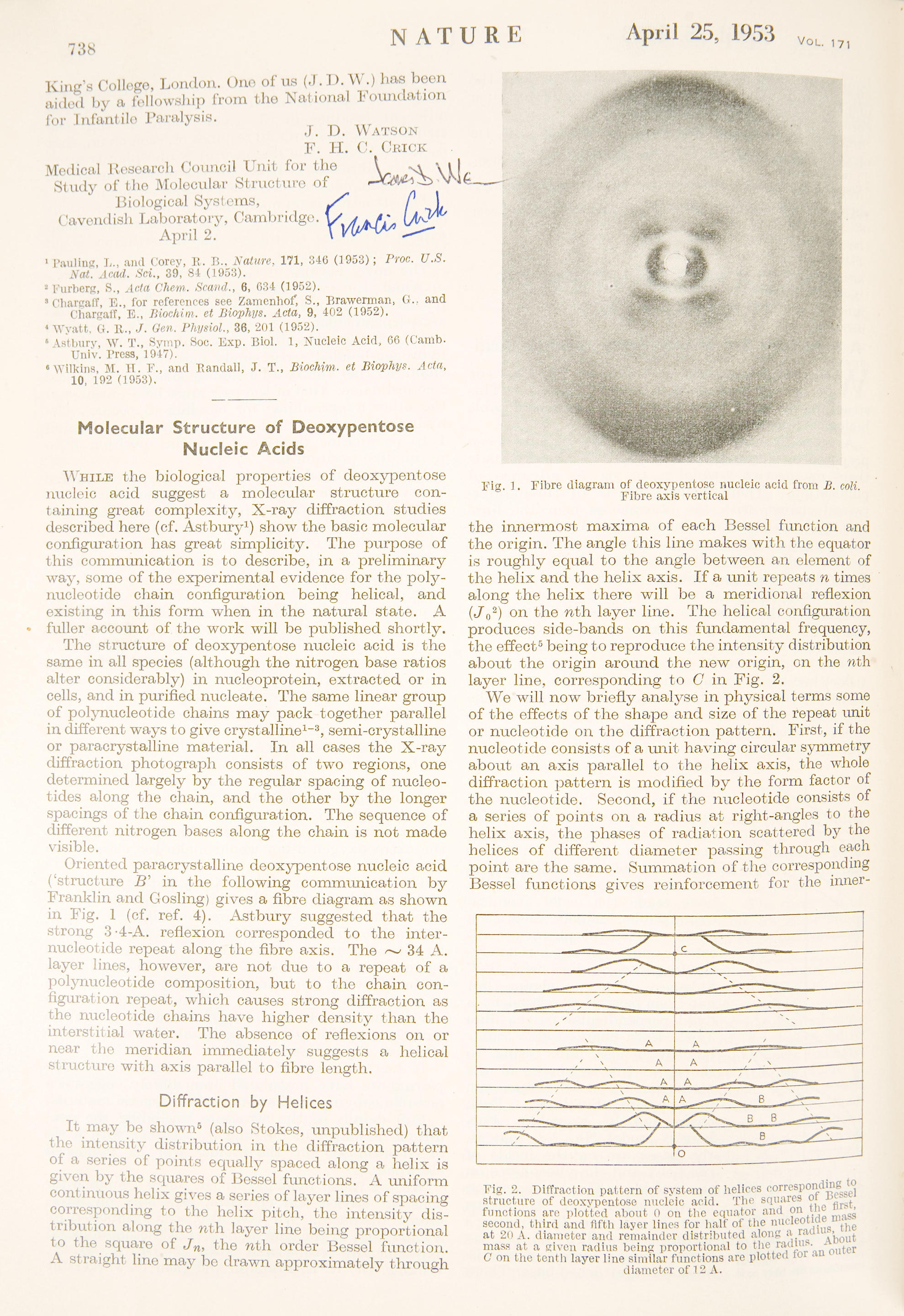WATSON, James Dewey (1928-) and Francis Harry Compton CRICK (1916-2004). "Molecular Structure of Nucleic Acids." Offprint from: Nature, vol. 171. London: Fisher, Knight & Co. Ltd., for Macmillan & Co., April 25, 1953.
WATSON, James Dewey (1928-) and Francis Harry Compton CRICK (1916-2004). "Molecular Structure of Nucleic Acids." Offprint from: Nature, vol. 171. London: Fisher, Knight & Co. Ltd., for Macmillan & Co., April 25, 1953. 8 o (210 x 139 mm). 6 conjugate leaves and 1 half leaf 7, 4 text illustrations including the double helix. Comprising "A Structure for Deoxyribose Nucleic Acid" by Watson and Crick, "Molecular Structure of Deoxypentose Nucleic Acids" by Maurice Wilkins, Alec Stokes and Herbert Wilson and "Molecular Configuration in Sodium Thymonucleate" by Rosalind Franklin and Ray Gosling. Self wrapper, stapled with the last leaf tipped at left edge onto proceeding page as issued. THE IMPORTANT FIRST ANNOUNCEMENT OF THE DISCOVERY OF DNA, SIGNED BY WATSON, CRICK, WILKINS, AND STOKES, THE SINGLE MOST IMPORTANT WORK IN THE HISTORY OF THE LIFE SCIENCES. James Watson arrived in Cambridge in October 1952, breaking in the process his Merck Fellowship in biochemistry and microbiology at Cophenhagen. He joined at the Cavendish Laboratory the most eminent group of crystallographers of the day. The Laboratory was headed by the Nobel Prize winner Sir Lawrence Bragg, but in Cambridge Watson worked with Francis Crick, aided by Maurice Wilkins and Rosalind Franklin of King's College, London. Their paper, with its memorable opening "We wish to suggest a stucture for the salt of deoxrybose nucleic acid (D.N.A.). This structure has novel features which are of considerable biological evidence," correctly interpreted the crystalline structure of D.N.A. This discovery explained how heridity messages could be encoded in a crystalline structure that was stable in the latter sense and yet allowed for both replication and mutation. Their published paper was a complete work - they did not reveal their work to the scientific community in stages - and thus its impact was all the greater. THE PUBLICATION OF THEIR JOINT PAPER IN NATURE REVOLUTIONIZED BIOCHEMISTRY AND THE OTHER LIFE SCIENCES, AND PROFOUNDLY AFFECTED THE STUDY OF MOLECULAR BIOLOGY. Watson and Crick published four papers in the summer of 1953. The first, offered here as a signed offprint, announced their discoveries to the world. This paper is remarkably restrained in tone, and their statement regarding the implication of their work for genetics is a masterpiece of understatement: "It has not escaped our notice that the scientific pairing we have postulated immediately suggests a possible copying mechanism for the genetic material." Their reticence, as Crick explained later, was the result of a compromise between the authors which recognised the need to claim priority but wishing also to avoid speculation.
WATSON, James Dewey (1928-) and Francis Harry Compton CRICK (1916-2004). "Molecular Structure of Nucleic Acids." Offprint from: Nature, vol. 171. London: Fisher, Knight & Co. Ltd., for Macmillan & Co., April 25, 1953.
WATSON, James Dewey (1928-) and Francis Harry Compton CRICK (1916-2004). "Molecular Structure of Nucleic Acids." Offprint from: Nature, vol. 171. London: Fisher, Knight & Co. Ltd., for Macmillan & Co., April 25, 1953. 8 o (210 x 139 mm). 6 conjugate leaves and 1 half leaf 7, 4 text illustrations including the double helix. Comprising "A Structure for Deoxyribose Nucleic Acid" by Watson and Crick, "Molecular Structure of Deoxypentose Nucleic Acids" by Maurice Wilkins, Alec Stokes and Herbert Wilson and "Molecular Configuration in Sodium Thymonucleate" by Rosalind Franklin and Ray Gosling. Self wrapper, stapled with the last leaf tipped at left edge onto proceeding page as issued. THE IMPORTANT FIRST ANNOUNCEMENT OF THE DISCOVERY OF DNA, SIGNED BY WATSON, CRICK, WILKINS, AND STOKES, THE SINGLE MOST IMPORTANT WORK IN THE HISTORY OF THE LIFE SCIENCES. James Watson arrived in Cambridge in October 1952, breaking in the process his Merck Fellowship in biochemistry and microbiology at Cophenhagen. He joined at the Cavendish Laboratory the most eminent group of crystallographers of the day. The Laboratory was headed by the Nobel Prize winner Sir Lawrence Bragg, but in Cambridge Watson worked with Francis Crick, aided by Maurice Wilkins and Rosalind Franklin of King's College, London. Their paper, with its memorable opening "We wish to suggest a stucture for the salt of deoxrybose nucleic acid (D.N.A.). This structure has novel features which are of considerable biological evidence," correctly interpreted the crystalline structure of D.N.A. This discovery explained how heridity messages could be encoded in a crystalline structure that was stable in the latter sense and yet allowed for both replication and mutation. Their published paper was a complete work - they did not reveal their work to the scientific community in stages - and thus its impact was all the greater. THE PUBLICATION OF THEIR JOINT PAPER IN NATURE REVOLUTIONIZED BIOCHEMISTRY AND THE OTHER LIFE SCIENCES, AND PROFOUNDLY AFFECTED THE STUDY OF MOLECULAR BIOLOGY. Watson and Crick published four papers in the summer of 1953. The first, offered here as a signed offprint, announced their discoveries to the world. This paper is remarkably restrained in tone, and their statement regarding the implication of their work for genetics is a masterpiece of understatement: "It has not escaped our notice that the scientific pairing we have postulated immediately suggests a possible copying mechanism for the genetic material." Their reticence, as Crick explained later, was the result of a compromise between the authors which recognised the need to claim priority but wishing also to avoid speculation.
.jpg)







.jpg?w=400?width=1600&quality=70)






Testen Sie LotSearch und seine Premium-Features 7 Tage - ohne Kosten!
Lassen Sie sich automatisch über neue Objekte in kommenden Auktionen benachrichtigen.
Suchauftrag anlegen